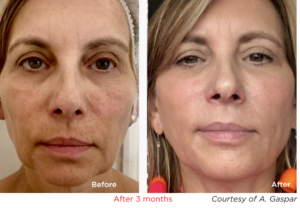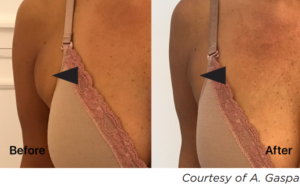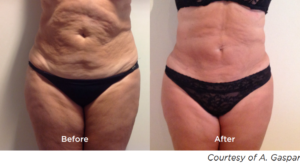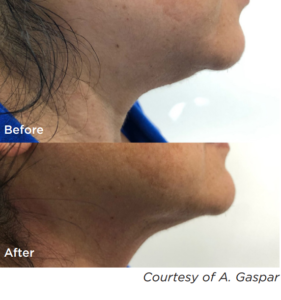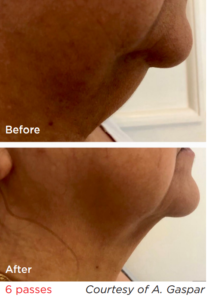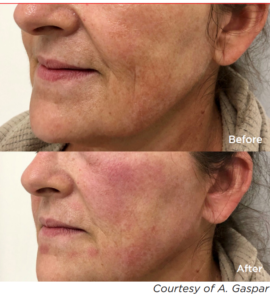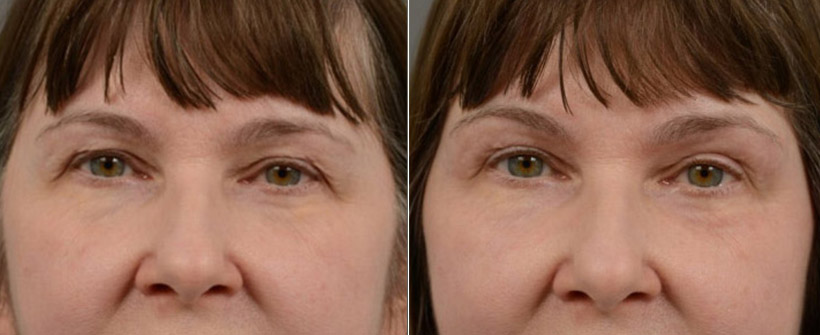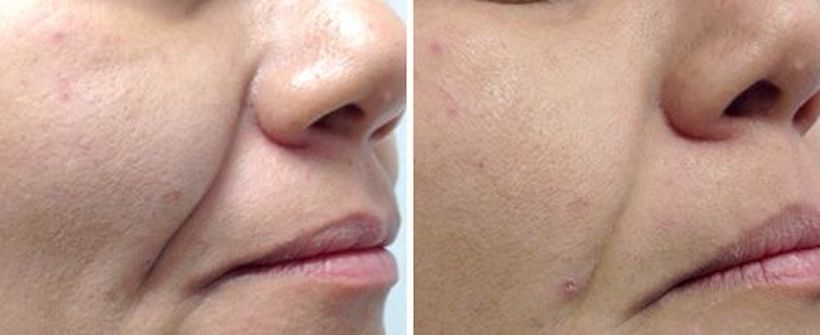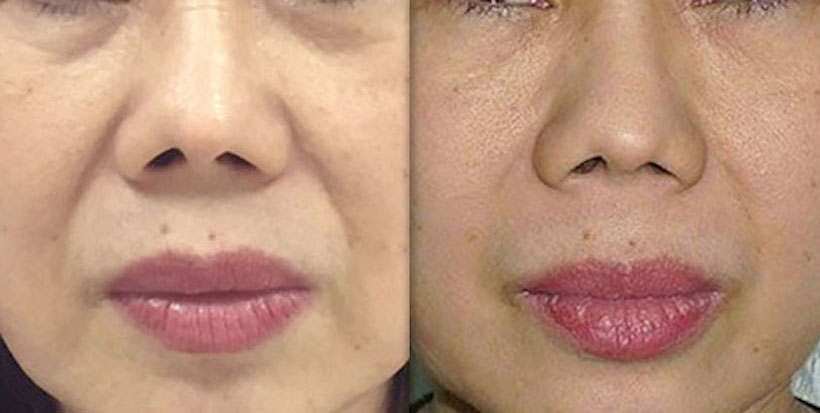Laser Skin Tightening with Fotona SP Dynamis
 Fotona SP Dynamis is an advanced and versatile laser which contains two wavelengths (Erbium 2094nm and long pulse Nd:YAG 1064nm). These can be used in many different combinations but what is unique about the Fotona SP Dynamis is that both these wavelengths can be delivered with a prolonged gentle delivery time which gently heats the skin. These prolonged delivery times are unique to Fotona and are not available in any other laser in the world. This gentle heating causes immediate tightening of the collagen as well as switching on new collagen production for several weeks. The result is tightening of slack/sagging skin and improvement in fine lines, wrinkles and skin quality.
Fotona SP Dynamis is an advanced and versatile laser which contains two wavelengths (Erbium 2094nm and long pulse Nd:YAG 1064nm). These can be used in many different combinations but what is unique about the Fotona SP Dynamis is that both these wavelengths can be delivered with a prolonged gentle delivery time which gently heats the skin. These prolonged delivery times are unique to Fotona and are not available in any other laser in the world. This gentle heating causes immediate tightening of the collagen as well as switching on new collagen production for several weeks. The result is tightening of slack/sagging skin and improvement in fine lines, wrinkles and skin quality.
Listed below are various Fotona SP Dynamis modes, settings/accessories and treatment combinations that can be utilised based on your unique needs and aesthetic goals. We invite you to click the links to learn about each option, or simply contact Dermatology Consulting today to book an appointment with our dermatologist—Dr Anne Farrell—to find out which treatment may be right for you.
- Fotona “Super PIANO®” Mode (used alone for tightening or as part of the “4D/5D Laser Face Lifting”
- Fotona Frac3® (used mainly in combination with other Fotona settings as part of the “4D/5D Laser Face Lifting” or alone for acne)
- Fotona SMOOTH® Mode (used alone for tightening or as part of the “4D/5D Laser Face Lifting”)
- 4D & 5D Laser Face Lifting
- Fotona T Runner (for tightening of larger areas e.g. abdomen, arms, knees, thigh)
Fotona “Super PIANO® Mode (used alone for tightening or as part of the “4D/5D Laser Face Lifting”)
What is Fotona “Super PIANO®” Mode Nd:YAG Skin Tightening?
Fotona “Super PIANO®” Mode is unique to the Fotona SP Dynamis laser and involves a very slow, gentle delivery time of the 1064nm long pulse Nd:YAG wavelength. This heats the deeper layers of the skin and leaves the top layer undamaged. The 1064nm wavelength heats water in the skin, but what is unique about Fotona “Super PIANO®” Mode mode is the prolonged gentle heating of the deeper skin. Research has shown that if the dermis of the skin is warmed to 42.5ºC–43ºC, it causes immediate tightening of the collagen. In addition, it also produces signals called “heat shock proteins,” which then stimulate more collagen production over the next few weeks. Continuous collagen production results in tightening of the skin, reduction of pores and softening of wrinkles. Because the heat is delivered slowly, the surface of the skin is not over-heated and therefore patients can have this done without any visible skin surface recovery time.
During the treatment the laser is gently passed over the surface of the skin and feels like a gentle warming of the skin. There is no need for local anaesthetic cream.
A very accurate external temperature camera is used to monitor the skin’s temperature throughout the entire procedure to ensure an adequate temperature is reached to stimulate collagen production.
If the skin temperature is maintained at 43ºC for at least 3 minutes there is optimal tightening from the Piano, hence the description as “Super Piano”.
What does the skin look like after Fotona “Super PIANO®” Mode Nd:YAG Skin Tightening?
Immediately after treatment, the skin looks slightly flushed. This effect usually settles within 15–30 minutes. Some patients see a pleasing immediate tightening which may settle slightly after a couple of days. However, the full effect appears after a few weeks, as more collagen is stimulated over time. Makeup can be worn immediately afterwards and normal activities commenced straight away.
On which parts of the body can Fotona “Super PIANO®” Mode be performed?
The treatment can be performed on all areas of the body. Popular sites include the jawline, neck, abdomen, inner arms and thighs. However, Fotona “Super PIANO®” Mode long pulse Nd:YAG cannot be used around the eyes. For treatment around the eyes, an erbium wavelength with a unique, slow delivery called Fotona SMOOTH® Mode is used to achieve skin tightening (a technique termed SmoothEye®, as discussed below).
When do I see an improvement with Fotona “Super PIANO®” Mode Skin Tightening?
New collagen is stimulated to develop gradually in the weeks and months after the treatment. We usually recommend a series of treatments, since repeated sessions give repeated stimulation of collagen production (for example: 6 treatments) and it is usually recommended to have the treatment at intervals of 3–4 weeks to give the heat shock proteins time to signal production of new collagen.
Is Fotona “Super PIANO®” Mode treatment suitable for all skin types?
The treatment is suitable for all skin types and colours, as it does not heat the surface of the skin. It can be done all year round, even if you have a tan.
How Long Do the Results of Fotona “Super PIANO®” Mode Last?
The results are permanent. For optimal results, most patients are encouraged to schedule several initial sessions, spaced around 3-4 weeks apart. This allows for continuous collagen production and more dramatic improvement. Once the desired results have been obtained, it is generally recommended that patients return every few months for a “top up treatment”, because we are all continuing to age, in order to boost collagen production.
How Much Does Fotona “Super PIANO®” Mode Cost?
Since Fotona “Super PIANO®” Mode can be used to treat nearly any region of the body, the cost of the treatment varies significantly depending on the individual patient and their goals.
Fotona Frac3®
What is Fotona Frac3® Nd:YAG Treatment?
Fotona Frac3® is a setting of the long pulse 1064nm Nd:YAG laser unique to Fotona. The Nd:YAG laser is set on a very short pulse duration of high power. This very short pulse duration creates a sudden, short controlled pulse of heat in the deeper layers of the skin. This creates microscopic wounds under the skin in a fractionated way which then stimulate growth factors and new collagen production. The surface of the skin is not affected, so there is no visible recovery time. It is good for “skin cleansing”, as it heats up oil in the pores, which, when done repeatedly improves and tightens pores, improves acne, improves skin texture and achieves some tightening. The laser energy can be delivered in an upwards vector direction to produce tightening of the collagen, which provides a “thread-lift-like” upwards pull on the skin.
The laser is gently passed over the treatment area of the skin and, at the same time, gentle cold air is blown onto the surface of the skin to protect the skin surface to protect it from overheating. All one should feel during the procedure is the gentle cool air. There is no need for local anaesthetic cream. When treating the face, the eyes are covered with goggles.
What does the skin look like after Fotona Frac3® Treatment?
Immediately after Fotona Frac3® treatment, the skin looks slightly flushed. This typically settles within approximately 5–15 minutes. Makeup can be worn immediately afterwards and normal activities commenced straight away.
When do I see an improvement with Fotona Frac3® Skin Tightening?
New collagen is stimulated to develop gradually in the weeks and months after Fotona Frac3® treatment which can improve skin texture and pore size. We usually recommend a series of treatments, since repeated sessions continue to stimulate collagen production (for example 6 treatments every 3–4 weeks). It is usually recommended to have treatment intervals of every 3–4 weeks to give time for the signals released by the laser treatment (called heat shock proteins) to signal production of new collagen.
Is Fotona Frac3® Treatment suitable for all skin types?
The treatment is suitable for all skin types and colours as it does not heat the surface of the skin. It can be done if you have a tan.
How Long Do the Results of Fotona Frac3® Last?
All Fotona treatments produce permanent improvement, but several sessions are needed and, as we all continue to age, “top up” treatments are beneficial.
How Much Does Fotona Frac3®Treatment Cost?
The precise cost of Fotona Frac3® treatment will depend on the number of sessions desired and the size of the area being treated.
The precise cost of Fotona Frac3® treatment will depend on the number of sessions desired and the size of the area being treated.
Fotona SMOOTH® Mode
What is Fotona SMOOTH® mode?
The Fotona SP Dynamis also contains a second type of laser called an erbium laser. Erbium laser (2094nm) has been used for a number of years as a laser resurfacing/laser peel and was developed as a gentler alternative to CO2 (carbon dioxide) laser. The erbium laser in the Fotona SP Dynamis is very flexible and can be used at a very light setting (similar to a microdermabrasion, with very little visible skin peeling afterwards) or a strong setting (which results in redness and swelling for several days and pinkness for several weeks, but which is very effective at reducing wrinkles and skin surface imperfections). The erbium in the Fotona SP Dynamis is unique in that the delivery time of the laser energy (called the pulse duration) can be made very long. This results in gentle, prolonged heat delivery to the skin, called the Fotona SMOOTH® mode setting, which results in skin tightening. This setting can be delivered anywhere on the outside surface of the skin, where it produces immediate tightening and can be delivered in a fractionated beam or full beam. It can also be used inside the mouth to tighten the cheeks and nasolabial folds. When used around the eyes, it can produce tightening of loose skin around the eyes, including heavy eyebrows (a treatment called SmoothEye®). When used around the lips it can produce some plumping of the lips (a treatment called “smooth lips”).
What does the skin look like after Fotona SMOOTH® Mode Skin Tightening?
If Fotona SMOOTH® mode is used at a low setting, there is very slight pinkness afterwards lasting a few minutes and no further signs. If a higher setting is chosen, there may be pinkness lasting 1–2 days followed by some mild flaking of the skin a day or two later. However, makeup can be worn straight away. There may be some immediate tightening visible which becomes more noticeable over the next few weeks.
Is Fotona SMOOTH® Mode treatment suitable for all skin types?
The treatment is suitable for all skin types and colours, but when performed on darker skin types (III- VI), i.e. Mediterranean skin types through to Asian and African skin types, there may be some slight temporary darkening of the treated skin. This fades with time but use of broad spectrum sunblock and, if desired, prescription lightening creams can speed up the resolution of any darkening.
What is “SmoothEye®” Treatment?
SmoothEye® treatment uses the smooth mode setting of the erbium laser of the SP Dynamis in a gentle, controlled heating technique to tighten the skin around the eyes.
It is done after applying local anaesthetic cream for 45–60 minutes. The erbium “smooth mode” setting gently heats the skin around the eye. Afterwards, the skin looks slightly pink and swollen, often with some faint speckled grey/white marks where the laser heated the skin. This lasts between 24 hours and one week, depending on the setting that was chosen.
The skin around the eyes starts to look tighter a few days later and this can continue to improve over several weeks. The treatment is best done once a month for 3–5 sessions to achieve the optimal results.
Fotona SmoothEye® Results
What is “Smooth Lip” Treatment?
“Smooth Lip” treatment uses a similar technique as SmoothEyes®, but it is applied around the lips. It results in temporary plumping of the lips, and, when done repeatedly, this effect can be long-lasting. It can be used as an alternative to fillers, eliminating the risk of bruising or blocking of blood vessels.
What is the Fotona “Smooth Sculpting” Treatment?
“Smooth Sculpting” is a method devised by Dr Farrell that uses the focused tightening effect of the Fotona SMOOTH® mode to tighten specific areas of concern to tighten certain sites and “sculpt” the face. The precise locations will be tailor made with you before the procedure, but frequently treated sites include the nasolabial folds, jowls, “marionette lines” and outer jaw angle. If done at low settings there is no recovery time. If done at higher settings there will be some slight pinkness for a couple of days and slight flaking lasting up to 10 days.
Smooth sculpting can be added at the end of other Fotona treatments.
Smooth sculpting can be added at the end of other Fotona treatments.
How Long Do the Results of Fotona SMOOTH® Mode Last?
Once the desired results of your Fotona SMOOTH® mode treatment have been achieved (usually over the course of several sessions spaced about a month apart), they can be quite long-lasting. That said, the ageing process will continue, so regular “maintenance” treatments can help preserve your results and increase their longevity. Dr Farrell can provide a more personalised recommendation for when and how often to come in for additional sessions during a consultation.
How Much Does Fotona SMOOTH® Mode Cost?
Fotona SMOOTH® mode can be used on a variety of different regions of the face and body, so the average cost varies based on the unique needs and aesthetic interests of the patient.
Fotona4D® Laser Face Lifting
What is the Fotona4D® Laser Face Lift?
The versatile nature of the SP Dynamis allows it to be used in several combinations and steps. To obtain the greatest benefit from the Fotona it is often best to combine four different settings, a technique known as Fotona4D® that is sometimes referred to as a “Laser Face Lift.”
The steps are:
- Step 1: Intra-oral Fotona SMOOTH® mode. The erbium laser SMOOTH® mode is used with a gentle, controlled heating setting inside the mouth to heat the inside of the cheeks. This technology is unique to the Fotona company and delivers the laser energy very slowly, resulting in heating and tightening of the inner cheeks. The Fotona SMOOTH® mode erbium technique has been used in dentistry for a number of years and results in a steady firming and tightening of the lower face. This is accomplished by heating the existing collagen and stimulating new collagen production deep under the skin. When done repeatedly, this treatment can help improve the appearance of the nasolabial folds and tighten loose skin on the lower cheeks. It is not uncomfortable, and as it is performed inside the mouth, there is no recovery time afterwards. For many patients, this treatment can act as an alternative to fillers.
- Step 2: Fotona Frac3®. The Nd:YAG laser is used at the Frac3® setting, which has a very short but high-powered pulse. This gently but rapidly creates tiny islands of heat below the surface of the skin in a fractionated pattern. It is good for improving skin texture and when done repeatedly improves pore size and acne, and achieves some tightening. There is no recovery time and it can be done with a tan.
- Step 3: Fotona PIANO® mode. The Nd:YAG laser is used at the Fotona PIANO® mode setting, which delivers heat slowly to the deeper layers of skin. Done repeatedly, it gently heats the skin, resulting in tightening and firming. The skin looks slightly pink for at most 15 minutes afterwards. Some patients see immediate tightening and this tightening effect improves over several weeks. There is no recovery time and it can be done with a tan.
- Step 4: Erbium Resurfacing Mode. The erbium laser is used to give a gentle superficial peel to the skin which helps peel away surface imperfections. The strength of the peel can be chosen according to the patient’s desires for improvement. Most clients have a very light fractionated peel, which gives a controlled very light partial peel without heating of the skin and very minimal flaking for a couple of days, ultimately giving a “pearl-like” finish to the skin. However, if a dramatic improvement is desired, a stronger erbium peel setting can be used, which will give redness and peeling lasting more days but will provide greater improvement of surface irregularities and pigmentation. However, very high-strength peels would not be as suitable for darker skin types as they may cause temporary darkening of the skin. Alternatively, the erbium laser can be used in the “Smooth Mode” for additional tightening in which case there will be no recovery time (if done at low settings), or slightly flaking (if done at higher settings).
The first three steps of Fotona4D® have no recovery time. The strength of the 4th step can be chosen to have very little recovery time or more recovery time depending on the setting chosen.
SmoothEye®, smooth lips, smooth sculpting and Fotona V-SMOOTH® with T runner can be added as extra steps after Fotona4D® treatment for additional tightening.
Over a few weeks, the skin of the treated area starts to look tighter and of better quality. The treatment is best done once a month for 3–5 sessions to achieve the optimal results. Many clients like to then do maintenance treatments every 6 months if under 50 years’ age and every 4 months if over 50 years’ age. Many patients chose Fotona4D® as an alternative to fillers.
Over the course of a few weeks, the skin around the treated area normally starts to look tighter and of better quality. The treatment is best done once a month for 3–5 sessions to achieve optimal cosmetic outcomes. Although the tightening and firming results of treatment can be quite long-lasting, many clients like to do maintenance treatments every 4-6 months depending on their age, skin quality, and aesthetic goals. Patients often choose Fotona4D® as an alternative to fillers. Fotona4D® laser face lifting is a dynamic and customisable procedure, so the precise costs will vary based on the unique needs and cosmetic goals of the patient. The T Runner is a specialised scanner that uses the Erbium:YAG wavelength of the Fotona laser in a non-ablative way to drive the laser energy into the surface tissue, which produces tightening of the skin. The controlled surface tissue heating stimulates collagen remodelling and over time improves the elasticity of the skin and reduces laxity. It can be used either alone or in combination with the Fotona PIANO® mode. Research has shown that if the dermis of the skin is warmed to 42.5ºC–43ºC this causes immediate tightening of the collagen. In addition, it also produces signals called “heat shock proteins,” which then stimulate more collagen production over the next few weeks, resulting in tightening of the skin. The T Runner scanner delivers the heat very precisely, rapidly and evenly to achieve an equal effect on all the areas treated. In addition, it has a built-in temperature sensor to measure both the energy delivered and the temperature reached for safety and to reduce discomfort. The treatment feels like short, intense bursts of heat. Numbing cream may be applied beforehand if one is particularly sensitive. Immediately after treatment, the skin typically looks flushed and there may be some temporary pick wheals, and this effect settles within approximately 45–60 minutes. Some patients see a pleasing immediate tightening which may settle slightly after a couple of days. However, the full effects of treatment usually appear after a few weeks as more collagen is stimulated. Makeup can be worn immediately afterwards and normal activities commenced straight away. The T Runner treatment can be performed on almost all areas of the body. Popular sites include the jawline, neck, abdomen, inner arms and thighs. However, the T runner scanner cannot be used around the eyes; instead for tightening the skin around the eyes, the Fotona SMOOTH® mode is used (as discussed above). The T runner can be added as an additional tightening step after Fotona4D® laser face lifting. New collagen is stimulated to develop gradually in the weeks and months after the treatment. We usually recommend a series of treatments, since repeated sessions continue to stimulate collagen production (for example: 4–6 treatments once every 3–4 weeks). It is usually recommended to have the treatment every 3–4 weeks to give the heat shock protein time to signal production of new collagen. The treatment is suitable for all ages, skin types and colours and can be done all year round, although it is better if you do not have a tan. In order to achieve optimal tightening results, it is recommended that patients schedule several treatment sessions, spaced about a month apart. This allows for continuous collagen stimulation and more dramatic skin tightening effects. Once the desired results have been achieved, Dr Farrell can discuss long-term maintenance and potential follow-up treatments with you. Since the Fotona T Runner treatment can be performed nearly anywhere on the body, the precise costs will vary depending on several factors, including the number of areas treated and the size of the treatment area(s). Dr Farrell and our team can give you a personalised price quote after your consultation appointment.
Fotona4D® Laser Face Lifting Results
Fotona T Runner
What is the “Fotona T Runner for Deeper Skin Tightening”?
What does the skin look like after the Fotona T Runner treatment?
On which parts of the body can Fotona T Runner be performed?
When do I see an improvement with T Runner Deeper Skin Tightening?
Is T Runner Deeper Skin Tightening suitable for all skin types?
How Long Do the Results of Fotona T Runner Last?
How Much Does Fotona T Runner Cost?
Fotona T Runner Results
